A nonprofit group is seeking a special Island County designation that might allow offices and community education facilities to be built on a scenic piece of Central Whidbey property.
At the request of the Whidbey Camano Land Trust, Island County is considering a Comprehensive Plan amendment that would allow for the creation of a Special Review District at the Keystone Farm and Forest Preserve, a 216-acre property on Admiralty Bay.
Following a discussion with county commissioners on Sept. 6, the Island County Planning Commission will hold a public hearing on the land trust’s request during a meeting at 6 p.m. Wednesday, Sept. 18 in the commissioners’ hearing room.
According to the 2016 Comprehensive Plan, properties eligible for the Special Review District classification are at least 150 acres, are owned by a nonprofit or a single public agency and present characteristics and intended uses so unique they are hard to classify.
Hence, a property might need special consideration to allow for future projects, according to a memo by the Planning and Community Development. The classification would additionally establish special standards to protect historically and environmentally relevant features while also allowing for uses that enhance and protect them, providing a consistent set of rules to follow.
According to information provided in the agenda packet, there are currently two special review districts, the Greenbank Farm and the Pacific Rim Institute on Central Whidbey.
Ryan Elting, the land trust’s executive director, said in an interview that the nonprofit is pursuing the Special Review District classification to determine whether it’s possible to build permanent offices and community education facilities at the preserve, which wouldn’t be allowed under the current agricultural and rural forest zoning.
The land trust applied for the amendment in 2023, Long Range Planner John Lanier told the Island County Commissioners on Sept. 6.
The land trust’s office is currently located at the Greenbank Farm, and with a wide range of stewardship and restoration activities and community partnerships planned for the Keystone property, Elting believes it would be beneficial to have a stronger presence at the property, which would then allow the preserve to become “a center for conservation in the Salish Sea,” he said.
“Whether or not we can physically locate our offices here is a big decision for the land trust and that would affect the delivery of our programs,” he said.
If the county approves the land trust’s request, the nonprofit will reach out to the community to see if there is support for the idea, then the board of directors will determine if it makes sense to move forward, Elting said.
If the proposal fails to get the county and the public’s approval, the nonprofit would still have a regular presence on the site and most of the plans for the preserve would still happen under current agricultural and forest zoning, Elting said.
After Lanier presented the idea at the Sept. 6 meeting, the county commissioners said they were supportive but had some concerns.
Commissioner Jill Johnson said she worried that approving the request would lead to unanticipated outcomes, like a large construction project.
Johnson and Commissioner Janet St. Clair also worried about setting standards for the rest of the county but exempting some from those standards. Commissioner Melanie Bacon was worried about potential impacts of events to neighboring areas.
With a Special Review District, the land trust wouldn’t need to apply for a separate land use permit on top of the building permit if it wants to add a new office or barn, Lanier said. Furthermore, the property would still be subjected to critical area regulations, the Shoreline Master Program regulations and land development standards. New development would also be far enough to not have a large impact on neighboring areas, he said.
After the public hearing, the county might proceed with the development and approval of the code. If approved, the code will be added to the Comprehensive Plan amendment, Lanier confirmed during the meeting.
The land trust purchased the $9.1 million property in 2022, and expects it will open to the public in 2025.
Over the past two years, the volunteers and stewardship staff have improved the entrance road, created a parking lot, removed an old beach house and planted 150 Garry oaks in partnership with the Oak Harbor Garry Oak Society. The land trust will also remove 300 feet of shoreline armoring, re-meander a stream and restore 16 acres of vegetation on the bluff, Elting said.
With funds from Conservation Futures, the land trust is also creating ADA trails and an education pavilion in partnership with Island County. The Organic Farm School will farm the non-restored lands to showcase sustainable agricultural practices.



